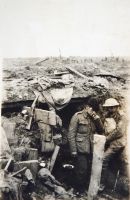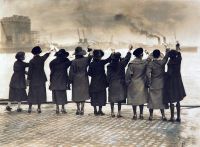In 2003 Surrey History Centre was privileged to take in the records of The Queen's Royal Surrey Regiment and its distinguished predecessors, which had formerly been housed at Surrey Infantry Museum.
 The Regiment was formed in 1959 when The Queen's Royal Regiment (West Surrey) (QRWS) and The East Surrey Regiment (ERS) were amalgamated. In 1966 it was absorbed into The Queen's Regiment, with a headquarters in Canterbury, thus ending the association of the county of Surrey with a regular regiment of the British Army.
The Regiment was formed in 1959 when The Queen's Royal Regiment (West Surrey) (QRWS) and The East Surrey Regiment (ERS) were amalgamated. In 1966 it was absorbed into The Queen's Regiment, with a headquarters in Canterbury, thus ending the association of the county of Surrey with a regular regiment of the British Army.
The Queen's Royal Regiment (West Surrey), the second oldest infantry regiment in the British Army, traced its origins back to 1661, and was originally formed to defend Tangier in North Africa, which Queen Catherine of Braganza had brought to Charles II as part of her dowry. Later also known as the 2nd Foot, its association with Surrey began in 1881 when the regiment was reorganised as The Queen's (Royal West Surrey) Regiment with its depot at Guildford. In 1921 it was restyled The Queen's Royal Regiment (West Surrey).
The East Surrey Regiment, with a depot at Kingston upon Thames, was created in 1881 when the 31st (Huntingdonshire) Regiment of Foot and the 70th (Surrey) Regiment of Foot were amalgamated. The 31st was originally formed in 1702 as Colonel George Villiers' Regiment of Marines and its 2nd Battalion was formed into the 70th Regiment in 1758.
 The records, which span four centuries, are a wonderfully rich source for the lives and campaigns of those who served in the regiments, both with the regular battalions and in the militia, volunteer, territorial and conscript battalions. They bear witness to the military careers of 1000s of Surrey men, careers which took them through Europe and far beyond.
The records, which span four centuries, are a wonderfully rich source for the lives and campaigns of those who served in the regiments, both with the regular battalions and in the militia, volunteer, territorial and conscript battalions. They bear witness to the military careers of 1000s of Surrey men, careers which took them through Europe and far beyond.
There are diaries and photographs of men serving in India and on the North West Frontier, against the Boers in South Africa, in the Far East, in the Crimea, and in northern Russia. There are the harrowing casualty returns and war diaries of battalions on the western front in the First World War, and first hand accounts of Dunkirk and the Burma Campaign. The routines of daily life in peace time are reflected in the series of battalion orders, in letters home and in photographs of sporting competitions and hunting expeditions in India.
 The voices that can be heard talking through the records are not just those of the officers but of the private infantrymen too. There are plenty of examples of unofficial battalion and company newsletters and magazines which, amidst the jokes that don't bear repeating, give some insight into how those units maintained their morale and spirit in the most appalling circumstances and contrast poignantly with the unemotive casualty reports and the private sentiments expressed in letters.
The voices that can be heard talking through the records are not just those of the officers but of the private infantrymen too. There are plenty of examples of unofficial battalion and company newsletters and magazines which, amidst the jokes that don't bear repeating, give some insight into how those units maintained their morale and spirit in the most appalling circumstances and contrast poignantly with the unemotive casualty reports and the private sentiments expressed in letters.
Thanks to a generous grant from the Heritage Lottery Fund the records were all catalogued in detail and these catalogues can be searched online. A summary of the arrangement and content of the records is available.
Many of the records are the private papers, diaries, reminiscences and photographs donated by many of the men who served or by their families and descendants. We and Surrey Infantry Museum, which holds a collection of Colours, uniforms, medals, pictures and other artefacts, would be delighted to hear from anyone who has material relating to any of the regiments and their members.
See also
- Buried battles and veterans' voices
- Military records indexes
- Surrey recruitment registers
- The Queen's Royal West Surreys and the Boer War
- Nominal Roll of 1st Battalion East Surrey Regiment
- A Black Poppy: Private Harold Brown of the Queen's (Royal West Surrey) Regiment
- Heavy losses to the 1st Queen's, 1914
- The Queen's Prisoner of War Relief Fund
Useful links
- The website of the Queen's Royal Surrey Regiment
- Surrey in the Great War
- Surrey Regiment World War One Diaries
- To Journey's End and Beyond: the Life and Legacy of R C Sherriff
- East Surrey Regiment's "football" charge 1 July 1916
Images
- Dugout in Jeffery Trench, August 1917 (reference: ESR/1/12/14)
- Propaganda leaflet directed at 2/7th Battalion, The Queen's, in the Italian campaign, 1943 to 1945 (reference: QRWS/16/1/3)
- The girls they left behind. 2nd Battalion the East Surrey Regiment, leaving Dublin, 17 February 1922 (reference: ESR/3/13/13)

